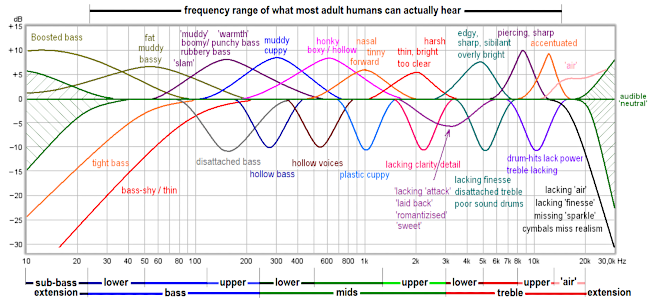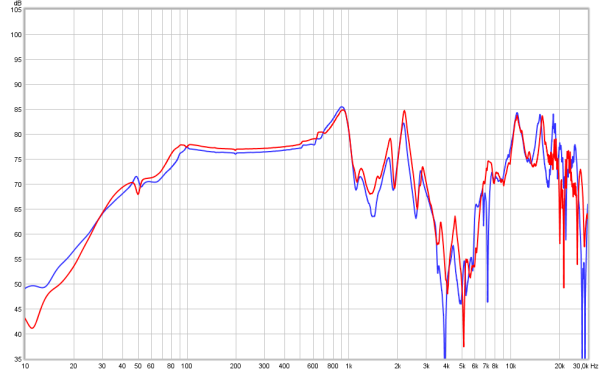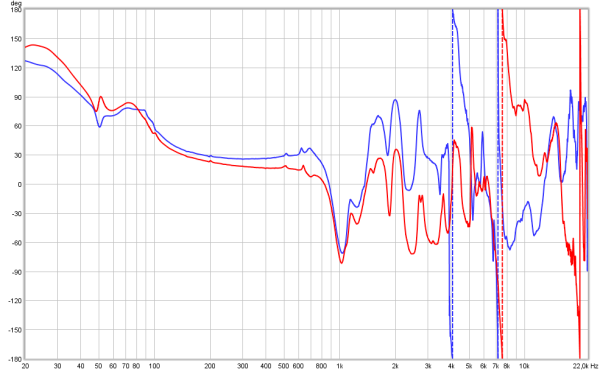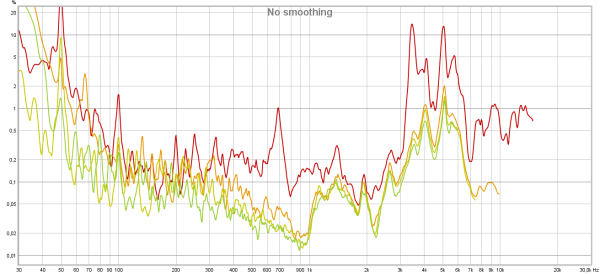EM6721
back to Philips
back to measurements
home
published: Jan-16-2023
NO SMOOTHING is applied to the shown plots. Most measurement sites have some smoothing applied which ‘irons flat’ sharp peaks and ‘wiggles’. I do not use smoothing because some info about sound quality is lost when plots are smoothed.
Aside from a small correction of the microphone itself also some correction in the lowest frequencies is applied to the plots to compensate for the perceived loss of bass when using headphones. This is described HERE in more detail.
A ‘horizontal‘ frequency response curve on the shown frequency response plots on this website thus indicates a perceived ‘flat’ tonal signature.
ALL measurements are made with a good SEAL on a flatbed measurement rig.
The shape of your head, bone structure, pad size, pad ‘softness, (compliance), hair or no hair and or wearing glasses may (drastically) change the frequency response of some headphones, so… your personal experience may differ substantially from these plots.
Frequency response (tonal balance) is the most sound-determining aspect of headphones. A horizontal line shows audible neutral response in the plots on this website. Deviations in different severity at different frequency bands have an effect on the sound character.
The bigger the deviation the stronger the effect.
Below an aid to help determining the sound character of headphones with relation to the frequency response.
Philips EM672

The Philips EM6721 is an open over-ear electret headphone. When this headphone came out at around 1983 around the birth of the DC player. I cannot find anything about it other than it seemed to be the top model.
The plastic and even pads survived the last 40 years. The drivers did not. The reason is this headphone is an electret headphone. Basically an electrostatic driver but without an external DC high voltage bias which requires an energizer.
An electret has a fixed static charge on the internal membrane. Alas, over the years this voltage drops and finally disappears. The sensitivity and sound quality as well as maximum sound pressure drops.
So the review is not about how this headphone measured sounded 30 to 40 years ago but what it became. The Stax Electret headphones are known to be much better in this aspect (loosing the static voltage). The membrane itself (I took the driver apart) physical tension was still O.K. and did not stick to any of the stators.
The 1.5m-3m coiled cable is not microphonic and terminates in a straight nickel-plated 6.3mm connector. The cable is fixed so cannot be replaced.
This headband was easily (clicked) adjustable over a good range and there is enough tilt and swivel so a good seal is always possible.
The faux-leather pads are glued on the baffle. These pads still were fine and even the foam inside still felt O.K. Not much room for the ears though. 13mm depth and 52mm inner diameter.
The driver itself was originally covered with thin black paper that prevented the driver from gathering dust (electrostatic charge attracts dust) and would have lowered the upper treble a bit. One of the previous owners most likely removed that paper.
It is an open headphone so outside noises are not attenuated much.
The sensitivity may have been in the 100dB/V range when new (can’t find any data on it) but since this one lost its charge it was 82dB/V. So basically it played 4x less loud than it once did.
As this is an electret it has a different load than dynamic headphones and will be mostly capacitive above 1kHz. For the lowest frequencies the load is close to 120Ω. Around 1kHz the load is around 900Ω, and 20kHz around 35Ω (but capacitive). The DC resistance of the transformer is 8Ω.
specifications:
Type: Over ear (circum-aural), open
Usage: Home
Driver type: electret
Pads: pleather, regular foam, fixed with double sided tape.
Collapsible: no
Headphone cup connector: fixed
Cable entry: dual sided.
Cable: 1.5m – 3m coiled cable terminated in a nickel-plated 6.3mm plug.
Inner Pad dimensions: depth = 13mm, diameter = 52mm.
Driver size: 70mm
Nom. power rating: 30mW (0.03W) @ 1kHz
Max. voltage: 5Vrms (14Vpp) @ 1kHz
Max. current: 100mA
Max. S.P.L.: 110 dB (@ 1kHz when new)
Impedance: 10-900 Ω (frequency dependent)
Sensitivity: around 100dB @ 1V @ 1kHz (when new)
Weight: 305 g. (without cable)
Clamping force: medium-low (4N)
Subjective sound description:
Well… this device is broken. The sound that still came out was poor quality (distorted) very soft and midrange only.
Measurements:
Below the frequency response of the (broken) EM6721 (Left, Right)
Note: this headphone is measured at 80dB SPL instead of the usual 90dB SPL because of its low sensitivity. Also note this headphone is basically broken (lost all sensitivity).
The channel matching is still good so it appears as though the loss of charge was about equal for both channels over the years. Bass is absent and starts to drop-off below 100Hz. This will always have been the case given the small transformer inside.
This makes the sound thin and lacking ‘body’. From 100Hz to 600Hz the response is pretty neutral. Above 600Hz the response is pretty much about the worst I have measured. Of course one should remember it is basically broken. upper treble is still there but the upper mids to lower treble is nowhere to be found.
phase response
Below the phase response of the EM6721 (Left, Right) Slow phase shifts are not very audible. Sharp changes in a narrow frequency bands may well be audible. Above 800Hz the phase response is terrible.
Slow phase shifts are not very audible. Sharp changes in a narrow frequency bands may well be audible. Above 800Hz the phase response is terrible.
output resistance / damping-factor
As this is an electret headphone the frequency response will be amplifier output resistance dependent when certain higher output resistance amplifiers are used.
Instead of showing impedance plots, which are hard to ‘read’ when it comes to assessing the tonal balance change in the real world, the EM6721 is measured via a few different resistance outputs (0.2Ω and 120Ω). On a higher output resistance amplifier the output level will be lower of course due to voltage division. To compensate for this the amplifier is cranked up a bit to the same level (1.1dB for 120Ω at 1kHz in this case). This way the plots are overlaid and it is easier to see how the tonal balance changes.  The change in impedance below 1kHz (transformer resistance) and above 6kHz (capacitance of driver) is evident in the impedance plot. A higher output resistance output (receivers, tube gear etc) would thus have resulted in less brilliance and a little less ‘body’ to the already bass-shy sound.
The change in impedance below 1kHz (transformer resistance) and above 6kHz (capacitance of driver) is evident in the impedance plot. A higher output resistance output (receivers, tube gear etc) would thus have resulted in less brilliance and a little less ‘body’ to the already bass-shy sound.
Below the distortion measurements of the EM6721 (Right channel).
The measurements are made at 80dB SPL. The plot above shows the level differences between the signal (upper trace) and the harmonics.
The plot above shows the level differences between the signal (upper trace) and the harmonics.
Most people prefer to see percentages instead of level differences so below the exact same plot except ‘normalized’ to the actual signal and level differences given in percentages. Distortion in the lows is quite high because the small transformer is not capable of delivering enough power. The distortion between 3kHz and 7kHz appears bigger than it is in reality because of the drop in sensitivity in that area. Harmonics in that frequency range would be about 40dB down (so around 1% instead of the reported 10%)
Distortion in the lows is quite high because the small transformer is not capable of delivering enough power. The distortion between 3kHz and 7kHz appears bigger than it is in reality because of the drop in sensitivity in that area. Harmonics in that frequency range would be about 40dB down (so around 1% instead of the reported 10%)
The actual 2nd harmonic distortion above 1kHz may well be lower than 0.2% . A shortcoming of my measurement rig.
Below the CSD (waterfall) plot of the EM6721. (Left and Right are overlaid)
Yes, this is a mess. resonances at 900Hz and 2.1kHz as well as a lot of them above 6kHz.
Electret driver
Below a picture of what’s inside the EM6721. An electret driver and step-up transformer. There is a small transformer. It has a ratio of 1:25 so when 4V is present on the plug there will be 100V (at 1kHz) across the driver.
There is a small transformer. It has a ratio of 1:25 so when 4V is present on the plug there will be 100V (at 1kHz) across the driver.
The driver itself is 70mm in diameter and consists of 2 perforated aluminium discs (1.3mm thickness) which are called ‘stators’. Sandwiched between the 2 stators there is a thin foil with some ‘impregnated’ static charge on it. Electrostatic drivers have 3 wires. One connected to each stator and one to the (conducting) membrane. The energizer that comes with those applies a high voltage to the membrane. Dependent on the model somewhere around a 300V to 500V.
The capacitance is 110pF. The stator distance is 0.45mm (so only 0.2mm between stator and membrane). This also means there is not much room for the membrane to move so low frequencies can not be loud anyway.
Below the operation principle. A (tensioned) membrane is sandwiched between 2 metal plates (stators) with holes in to let sound pass. On an electret the bias voltage is not applied externally.
A positive charge on one side and an equal in level but opposite in charge voltage (the audio signal) is applied to the stators. This voltage needs to high so a transformer is used.
When one side is positive and the other side is negative the membrane (with a fixed electrostatic charge on it) is drawn towards one side and repelled from the other side. This produces the sound.
When the static charge on the membrane is no longer there the membrane won’t be attracted/repelled any more. So how loud the driver is not only depends on the applied voltage but also the charge of the membrane.
An electret is also an electrostatic driver (same principle) but the membrane has a charge embedded into it and is not connected via a wire (bias voltage). When this driver looses its charge the driver looses its loudness and distortion increases. This is what happened to this one. Stax electrets seem to be better at holding their charge over time. It also will get lower but just not as fast.
When looking for an electrostatic headphone it may be best to avoid electrets, certainly when they are not made by Stax. One should always check for sensitivity (how loud it can go) and channel imbalance issues. One driver may loose sensitivity quicker than the other resulting in the sound leaning to one side.
Sadly, the only thing of value this headphone has is the coiled cable. That will be going in the parts bin.
conclusion
The Philips EM6721 probably was a decent sounding headphone 40 years ago.
Alas, electrets loose their charge and once that occurs the headphone becomes worthless.
So before trying to buy an older electret make sure it is still playing loud enough and without distortion.

Hi,
I have successfully recharged a STAX SR-60 electret driver, using high voltage of a Van-der-Graaf-Generator.
It still works with full sensitivity and full specs, although it was not possibly to open the driver, it’s permanently sealed.
Only, I charged it with opposing polarity, which could be fixed by connecting it reversed.
Kind regards
Kai
For A Stax driver it would be worth the trouble.
This driver, even when it would be new, would not have any decent bass levels nor is it EQ’able at any reasonable volume.
The driver was easy to disassemble but do not plan to try to repair it.
Probably will salvage the cable.